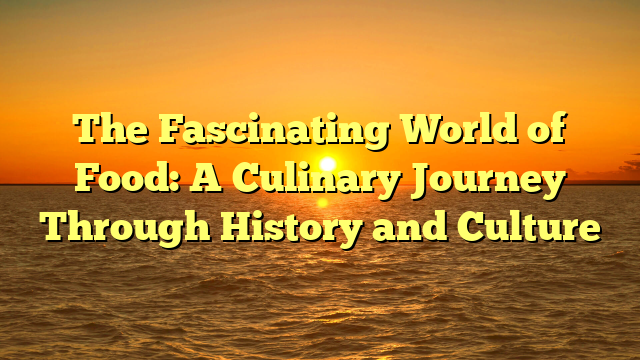
Food is much more than mere sustenance; it is a central element of human culture, history,
and identity. From the spices that shape cuisines to the techniques passed down through
generations, the variety and richness of food have evolved in parallel with the story of
humanity itself. Whether enjoyed in a street food stall or served in a Michelin-starred
restaurant, food has the power to bring people together, celebrate diversity, and offer a
glimpse into the values and traditions of different cultures around the world.
The Origins of Food
The origins of food can be traced back to the early days of humanity, where the need for
survival led to the discovery of tools for hunting, gathering, and eventually farming. The first
evidence of human agriculture dates back about 10,000 years, marking the beginning of the
shift from nomadic lifestyles to settled communities. Early civilizations such as the
Mesopotamians, Egyptians, and Chinese all contributed to the foundation of global cuisine
by cultivating crops like wheat, barley, rice, and legumes, and by domesticating animals like
cattle, goats, and chickens.
As humans began to settle into agricultural societies, the types of food consumed expanded.
Food was no longer simply a matter of survival; it became a way to express identity, wealth,
and status. In ancient Egypt, for example, bread and beer were staples of the diet and
represented the everyday life of the working class, while feasts with imported foods such as
spices and honey were reserved for the elite.
The Role of Spices in Cuisine
One of the most significant influences on the development of global cuisine has been the
use of spices. Spices are not only used for flavoring but also for preserving food and offering
health benefits. The use of spices dates back to the ancient trade routes, where exotic
goods were exchanged between the East and West. Spices like black pepper, cinnamon,
turmeric, and saffron played a crucial role in the creation of distinct culinary traditions across
the globe.
In ancient India, the use of spices such as turmeric, cumin, and cardamom was deeply
intertwined with the region’s cultural practices, and these flavors traveled westward to the
Middle East and Europe. The spice trade eventually led to the Age of Exploration, as
European explorers set out to find new trade routes to access these precious goods. The
desire for spices such as nutmeg, cloves, and pepper was one of the driving forces behind
European expansion into Africa, Asia, and the Americas.
Spices not only shaped the way food tastes but also helped preserve perishable goods. In
the hot climates of Southeast Asia, for example, spices were used in marinades to prolong
the freshness of meat and fish. Similarly, the use of salt and spices to cure meats became
central to European preservation methods, leading to the creation of cured meats such as
salami and prosciutto.
bayar4d of Food
With the rise of trade networks, the movement of foodstuffs became globalized. The
Columbian Exchange, named after Christopher Columbus, was a period during which foods,
plants, animals, and diseases were exchanged between the Old World (Europe, Asia, and
Africa) and the New World (the Americas). This exchange had a profound impact on food
culture worldwide.
For example, the introduction of tomatoes, potatoes, and corn from the Americas
dramatically altered European diets. The tomato, once considered a strange and potentially
poisonous fruit, became a cornerstone of Italian cuisine, while the potato became a staple
crop in Ireland and Russia. Similarly, foods such as wheat, coffee, and sugar were brought to
the Americas, where they would become key components of the region’s agricultural
economy.
The blending of ingredients and cooking techniques from different parts of the world gave
rise to fusion cuisines that became increasingly popular. Dishes such as the French baguette
filled with Chinese-style duck, or the Japanese sushi topped with Peruvian-inspired ceviche,
are just a few examples of how globalization has enriched culinary traditions. The continuous
exchange of ideas and ingredients is responsible for the diversity we see on modern menus
around the world today.
The Modern Food Landscape
Today, the world of food is as dynamic and diverse as ever. While traditional dishes continue
to be passed down through generations, the global interconnectedness of the modern world
has led to an explosion of new culinary styles and trends. Social media platforms like
Instagram and YouTube have given rise to food influencers and bloggers, who share
recipes, restaurant reviews, and cooking tips to a global audience.
Sustainability is another important trend shaping the future of food. As concerns over climate
change and environmental degradation grow, consumers and producers alike are turning to
sustainable and ethical food practices. From plant-based diets to locally sourced ingredients,
people are increasingly mindful of how their food choices impact the planet.
In addition to sustainability, there has been a growing interest in the health benefits of food.
Many people are turning to superfoods—nutrient-dense foods like kale, quinoa, and chia
seeds—as a way to improve their overall well-being. Similarly, the rise of dietary restrictions,
including gluten-free, dairy-free, and keto diets, reflects a broader shift towards personalized
nutrition that caters to individual needs.
The Future of Food
As we look toward the future, food will continue to be shaped by innovation and creativity.
Technological advancements such as lab-grown meat, vertical farming, and 3D-printed food
have the potential to revolutionize the way we produce and consume food. With the global
population expected to reach nearly 10 billion by 2050, finding sustainable and efficient ways
to feed the world will be critical.
Food is also becoming an increasingly interactive experience. Virtual reality and augmented
reality are beginning to merge with dining, offering new ways for people to engage with their
food. Chefs are experimenting with new textures, flavors, and presentations, creating dishes
that challenge our senses and expectations.
Conclusion
Food is far more than just something we eat; it is a reflection of history, culture, and
innovation. From ancient grains to cutting-edge culinary techniques, food continues to evolve
in response to the needs and desires of people around the world. Whether it’s a humble
home-cooked meal or a groundbreaking gastronomic creation, food remains an essential
part of the human experience, offering nourishment, connection, and endless opportunities
for discovery. As we move forward, one thing is certain: food will continue to play a central
role in shaping our lives and our world.



